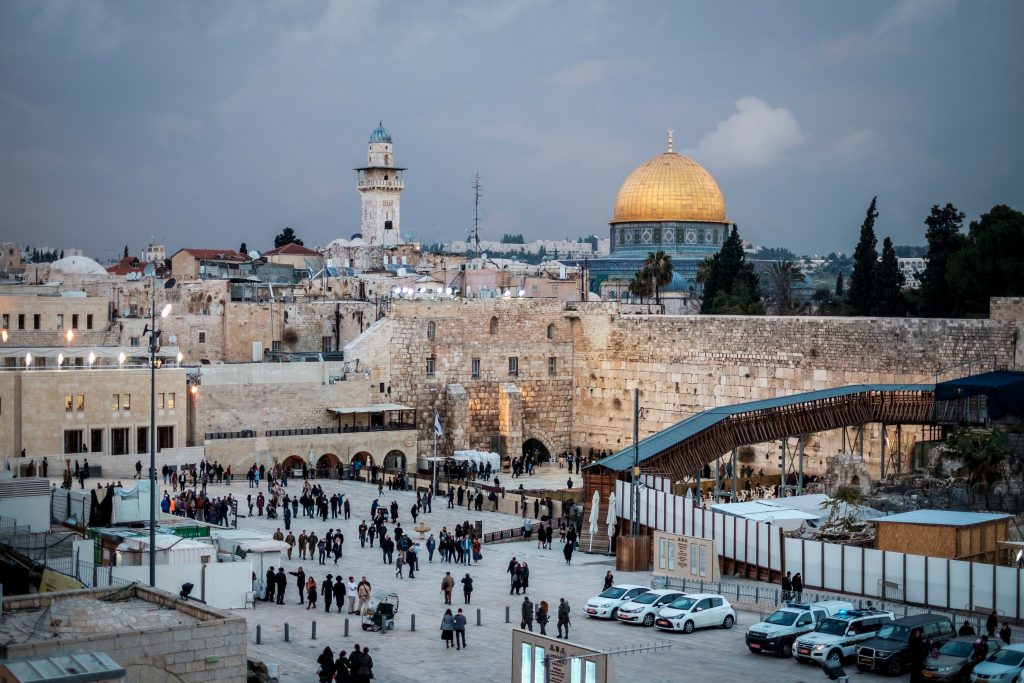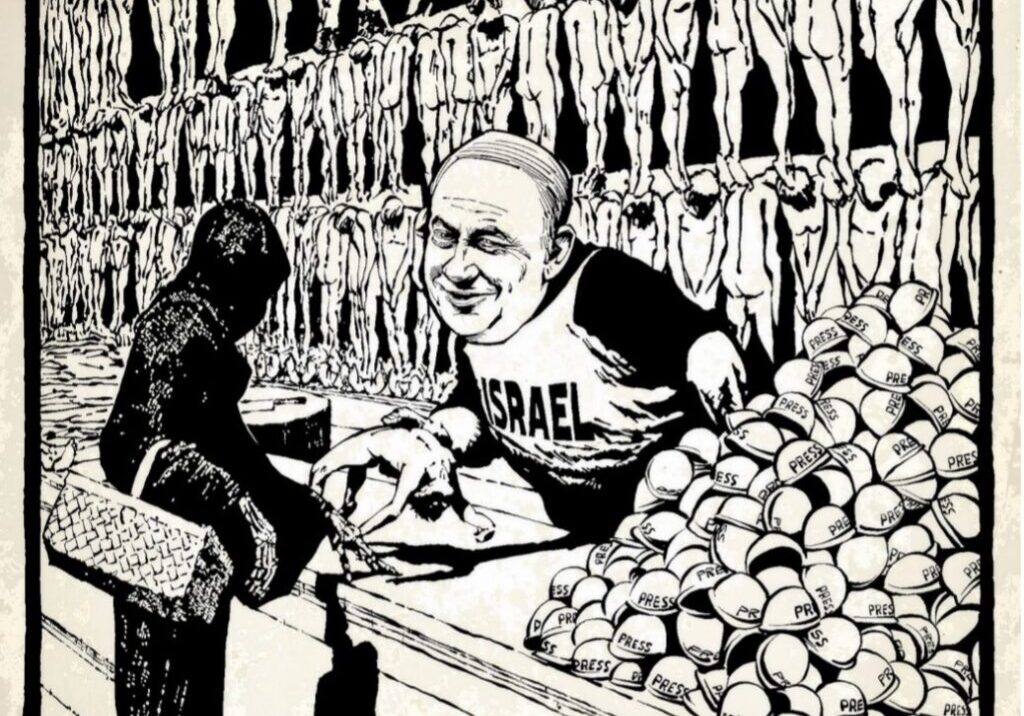Australia/Israel Review
Essay: A Clash of Worldviews
Oct 3, 2022 | Sheree Trotter

From Rushdie to the Temple Mount
The Aug. 12 attack on renowned author Salman Rushdie at an Arts event in Chautauqua, upstate New York, sent shockwaves through the literary community. Stabbed by a man incensed by the perceived insult to Islam in Rushdie’s 1988 novel The Satanic Verses, the attack was a stark reminder of a clash of worldviews – the dissonance between those who embrace Western values of free expression and those whose religious sensibilities drive them to violence over a perceived insult.
The worldview clash is not confined to the literary world. Indeed, this is the same clash we see played out annually in Jerusalem, particularly on the Temple Mount, and often with grave consequences.
My first visit to the Temple Mount’s vast esplanade took place on an early winter morning. The magnificent arches cast long shadows in the soft morning light. My fellow Kiwi travellers and I had time for a quick perambulation and a few phone snaps to remember the moment before heading off for another tightly packed day of activities. The elevated position afforded a seldom-seen view of the Old City and surrounding districts. The quiet, peaceful atmosphere contrasted with the scenes of tension often associated with this most holy of sites.
The Temple Mount, known as Haram al-Sharif by Muslims, has deep religious significance for both Jews and Muslims.
If Jerusalem is the crown of Jewish history and longing, then the Temple Mount is the foremost jewel in that crown. It is the most sacred site in Judaism. It is considered the site of Mount Moriah, where Abraham offered his son Isaac as a sacrifice. It is also the location of the two Jewish temples: Solomon’s, which according to biblical sources, stood from the 10th century BCE until 586 BCE, and the Second Temple, 515 BCE to 63 CE.
For Sunni Muslims, Haram al-Sharif is their third holiest site after Mecca and Medina. It houses two major shrines, the Dome of the Rock built in the late 7th century, over the rock from which Muhammad is said to have ascended to heaven, and the Al-Aqsa Mosque, built in the early 8th century, the largest mosque in Jerusalem.
Given the great religious significance of the Temple Mount to both Jewish and Islamic traditions, it is not surprising that it has been a focus of much tension. Indeed, it has become almost a yearly event for violence to break out on the Temple Mount, particularly as the time of the Muslim holy month of Ramadan approaches. 2022 was no exception.
Fuelled by allegations that a handful of Jewish zealots were seeking to perform the sacrifice of a goat somewhere on the Temple Mount in observance of the Passover holiday, Palestinian activists rallied their forces to “defend the Al-Aqsa Mosque.” Large stones were hurled from the Temple Mount onto the Jewish prayer area at the Western Wall below. Weapons were gathered and stored in the Al-Aqsa Mosque in preparation for the riots of the subsequent days.
Israeli security forces stringently uphold the ‘status quo’ on the Temple Mount and have never allowed religious Jews to hold such ceremonies, which would be seen as highly provocative. On this occasion, the police arrested six Jews who were suspected of planning a Passover ritual on the Mount.
The “Al-Aqsa is in danger” claim has a long history, dating back at least to the early 20th century when the Grand Mufti of Jerusalem, Haj Amin al-Husseini, employed the trope to fire up passions.
Indeed, according to Israeli journalist Nadav Shragai:
Husseini’s behavior did not stem from religious faith alone. He concocted the “Al-Aqsa is in danger” libel as part of the building of the Palestinian national ethos, which in those days was still in its earliest stage. He identified the points of ostensible overlap and competition over the holy places of the two religions, emphasized them, and used them as fuel for the fire. The higher its flames rose, the better his purposes were served. (Source: The ‘Al-Aqsa Is in Danger” Libel: The History of a Lie, Jerusalem Centre for Public Affairs, 2012)
Alongside the propagation of this trope to fuel tension, Palestinian leaders have also attempted to erase the Jewish history of Jerusalem, overwriting it with their own narrative. Palestinian spokespeople have sought to de-Judaise the Mount, the Western Wall, and Jerusalem in general.
Indeed, the revisionism goes so far as to deny the Jewish Temples ever existed, even though they are attested by numerous archeological findings, in addition to written sources. While this may be difficult to believe for anyone with even a passing knowledge of Jerusalem, such disinformation is fully embraced by many in the Arab and Muslim world, having been promulgated for decades by Muslim leaders.
The current status quo at the site is largely traceable to Israel voluntarily relinquishing control of the Temple Mount following its recapture in 1967. The famous announcement “The Temple Mount is in our hands!” by the paratroop commander Mordechai Gur during the Six Day War was soon followed by Defence Minister Moshe Dayan’s decision to forbid Jewish prayer and worship on the Mount and to leave the Mount and its management in the hands of the Muslim Waqf (religious trust). Dayan hoped to avoid any possibility of religious conflict by granting Islam ongoing religious sovereignty. He sought to limit the Arab-Israeli conflict to the territorial-national level. As a secularist, Dayan completely underestimated the power of mingling religion with national, territorial and political goals.
Dayan maintained the ‘status quo’ which had governed the Temple Mount since Ottoman times. It regulates a range of activities on the mount, including access, hours of prayer, ritual, ceremonies, religious or otherwise, rules of dress and conduct, administrative regulations and management, the character of the site, and police and security protocols. Any shift to any aspect of these arrangements could ignite a violent conflagration.
Israeli diplomat and international law scholar Ambassador Alan Baker has recently argued regarding the Temple Mount status quo that:
A status quo that perpetuates an ancient and outdated social structure that no longer exists, that practices religious discrimination and denies or restricts rights of worship, should logically no longer be relevant and should not be maintained in modern international society. It is distinctly and blatantly incompatible with accepted international norms and concepts of equality, human rights, freedom of religion and worship, interreligious and intercultural dialogue, tolerance, understanding, and cooperation.
Baker is certainly correct in his assessment that the ‘status quo’ system indeed is out of step with international norms and values of human rights, freedom and tolerance. These are Western values that have been considered part of the bedrock of civilised society. But we are dealing here with a clash of worldviews. The strength of religious feeling that drives Muslim passions regarding the Temple Mount cannot be assuaged by such Western sentiments.
Israeli Arab cleric Sheikh Raed Salah is considered by many to be Haj Amin al-Husseini’s modern-day successor. Salah has revitalised the “Al-Aqsa is in danger” libel, incited violence, and promised to redeem Al-Aqsa “in fire and blood.” Salah’s vision is expansive. He speaks openly of “the global caliphate whose capital is Jerusalem,” which will be “the last stage in the history of the Muslim nation until the End of Days.”
Many Western commentators view the Israel-Palestinian conflict through the lens of power relationships. Thus, Israel is the powerful state actor exerting overwhelming force over hapless Palestinian refugees. And in line with current theories, the weaker party is automatically granted innocence while the stronger must of necessity be the villain. Such interpretations fail to understand the intransigence of Palestinian leaders, who are not merely rejecting “land for peace” deals, but ultimately any accommodation with Israel and the broader West. At the same time, Western powers attempting to impose “solutions” (i.e. further Israeli concessions), and “social justice” activists standing in solidarity with Palestinians, achieve little of value. Such actions affirm Palestinians in their uncompromising, maximalist demands and stand in the way of progress towards peace.
Israeli politicians hope that by improving opportunities for Palestinians they may mitigate some of the hardships that help fuel aggression. More broadly, improved relations with neighbouring countries via the Abraham Accords offer a different paradigm for the ongoing conflict. Meanwhile, on the ground, two fundamentally opposing visions continue to jostle for supremacy. Israel is compelled to increase security measures to keep civilians safe as political and religious leaders exploit the religious sensitivities surrounding the Temple Mount.
It would seem that Salman Rushdie, Moshe Dayan and Ambassador Alan Baker all share a common worldview, one that values freedom and human rights. Their adversaries reject those values. They are driven by a religious, apocalyptic vision that brooks no compromise toward those with whom they disagree.
Forging effective solutions first requires a correct diagnosis. Until Western leaders recognise the fundamental forces driving the conflict, we can expect little change.
Dr. Sheree Trotter is Co-Director of New Zealand’s Indigenous Coalition for Israel, Co-Director of the Israel Institute of New Zealand and a co-founder of the Holocaust & Antisemitism Foundation Aotearoa NZ.
Tags: Islamic Extremism, Israel, Palestinians, Temple Mount






